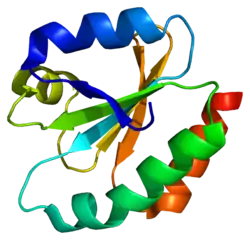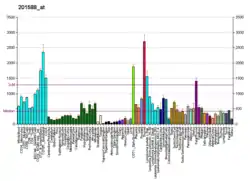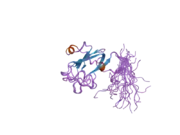TXNL1
Thioredoxin-like protein 1 is a protein that in humans is encoded by the TXNL1 gene.[4][5][6]
References
- GRCh38: Ensembl release 89: ENSG00000091164 - Ensembl, May 2017
- "Human PubMed Reference:". National Center for Biotechnology Information, U.S. National Library of Medicine.
- "Mouse PubMed Reference:". National Center for Biotechnology Information, U.S. National Library of Medicine.
- Miranda-Vizuete A, Gustafsson JA, Spyrou G (Mar 1998). "Molecular cloning and expression of a cDNA encoding a human thioredoxin-like protein". Biochem Biophys Res Commun. 243 (1): 284–288. doi:10.1006/bbrc.1997.8003. PMID 9473519.
- Lee KK, Murakawa M, Takahashi S, Tsubuki S, Kawashima S, Sakamaki K, Yonehara S (Aug 1998). "Purification, molecular cloning, and characterization of TRP32, a novel thioredoxin-related mammalian protein of 32 kDa". J Biol Chem. 273 (30): 19160–19166. doi:10.1074/jbc.273.30.19160. PMID 9668102.
- "Entrez Gene: TXNL1 thioredoxin-like 1".
Further reading
- Miranda-Vizuete A, Spyrou G (2000). "Genomic structure and chromosomal localization of human thioredoxin-like protein gene (txl)". DNA Seq. 10 (6): 419–24. doi:10.3109/10425170009015613. hdl:10261/47456. PMID 10826702. S2CID 38627981.
- Jin J, Chen X, Zhou Y, et al. (2002). "Crystal structure of the catalytic domain of a human thioredoxin-like protein". Eur. J. Biochem. 269 (8): 2060–2068. doi:10.1046/j.1432-1033.2002.02844.x. PMID 11985582.
- Strausberg RL, Feingold EA, Grouse LH, et al. (2003). "Generation and initial analysis of more than 15,000 full-length human and mouse cDNA sequences". Proc. Natl. Acad. Sci. U.S.A. 99 (26): 16899–16903. doi:10.1073/pnas.242603899. PMC 139241. PMID 12477932.
- Gevaert K, Goethals M, Martens L, et al. (2004). "Exploring proteomes and analyzing protein processing by mass spectrometric identification of sorted N-terminal peptides". Nat. Biotechnol. 21 (5): 566–569. doi:10.1038/nbt810. PMID 12665801. S2CID 23783563.
- Ota T, Suzuki Y, Nishikawa T, et al. (2004). "Complete sequencing and characterization of 21,243 full-length human cDNAs". Nat. Genet. 36 (1): 40–45. doi:10.1038/ng1285. PMID 14702039.
- Gerhard DS, Wagner L, Feingold EA, et al. (2004). "The status, quality, and expansion of the NIH full-length cDNA project: the Mammalian Gene Collection (MGC)". Genome Res. 14 (10B): 2121–2127. doi:10.1101/gr.2596504. PMC 528928. PMID 15489334.
- Kim KY, Lee JW, Park MS, et al. (2006). "Expression of a thioredoxin-related protein-1 is induced by prostaglandin E(2)". Int. J. Cancer. 118 (7): 1670–1679. doi:10.1002/ijc.21572. PMID 16231315. S2CID 21916723.
- Guo D, Han J, Adam BL, et al. (2005). "Proteomic analysis of SUMO4 substrates in HEK293 cells under serum starvation-induced stress". Biochem. Biophys. Res. Commun. 337 (4): 1308–1318. doi:10.1016/j.bbrc.2005.09.191. PMID 16236267.
- Jiménez A, Pelto-Huikko M, Gustafsson JA, Miranda-Vizuete A (2006). "Characterization of human thioredoxin-like-1: potential involvement in the cellular response against glucose deprivation". FEBS Lett. 580 (3): 960–967. doi:10.1016/j.febslet.2006.01.025. hdl:10261/46508. PMID 16438969. S2CID 18655983.
This article is issued from Wikipedia. The text is licensed under Creative Commons - Attribution - Sharealike. Additional terms may apply for the media files.





